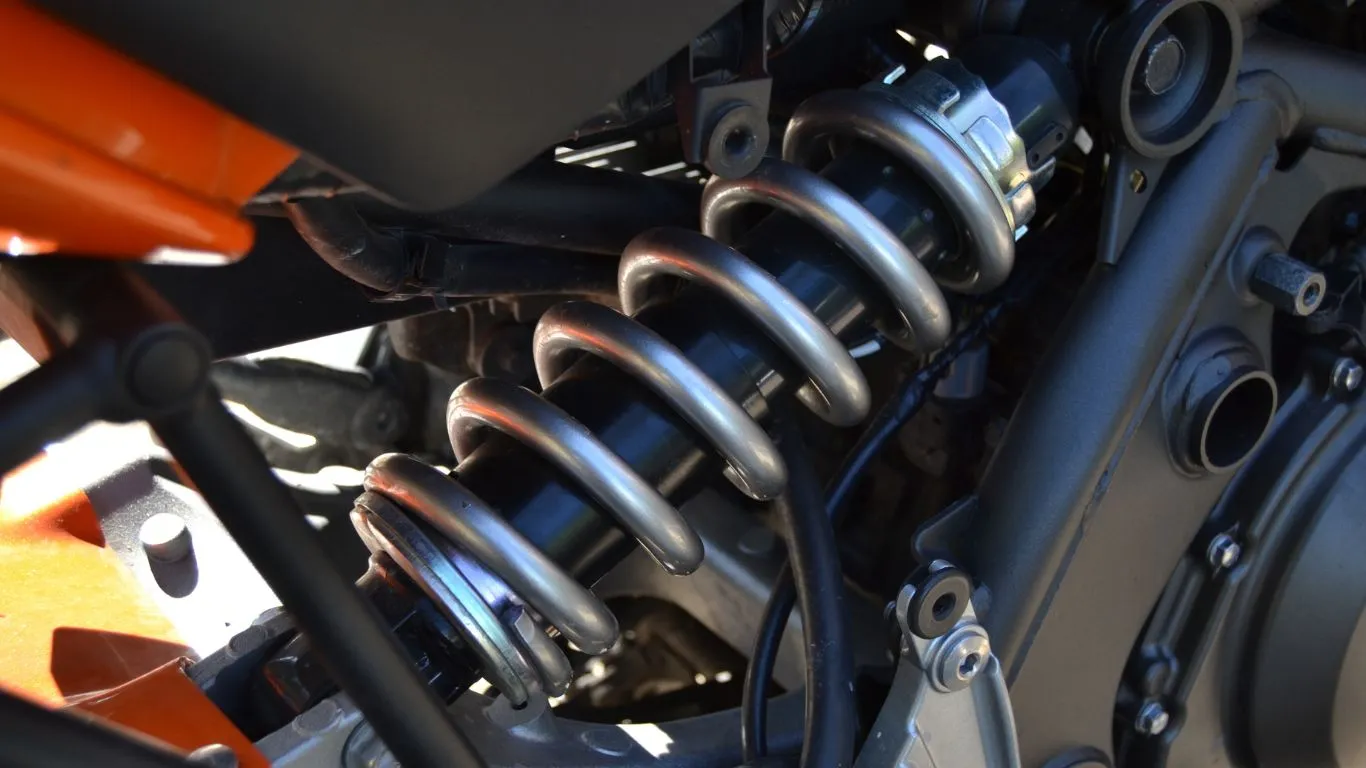Imagine riding your motorcycle on a smooth, winding road. The wind is rushing past you, the engine’s purring rhythmically, and you’re in perfect harmony with your machine. Suddenly, you hit an unexpected bump. Your bike jolts, disrupting your serene communion with the road. Here’s where the enchanting art of motorcycle suspension. It’s the unsung hero that ensures you glide over bumps and potholes, maintaining your bike’s stability and your comfort.
Just as the heart is fundamental to the body’s functioning, the suspension is to a motorcycle. This intricate orchestra of springs and dampers plays a pivotal role, much like a trapeze artist, absorbing road shocks with grace and precision. It ensures that your tires remain faithful to the ground, bestowing upon your ride a sense of control and comfort.
“Riding a motorcycle is an art – a thing that you do because you feel something inside.” – Valentino Rossi
No doubt, this quote holds truth. Yet, the mastery of motorcycle riding goes beyond mere gut feelings. It encompasses a deeper comprehension of your two-wheeled beast. A crucial facet, often ignored, lies in grasping the essence of motorcycle suspension and fine-tuning it to perfection.
Understanding the Different Types of Suspension
Motorcycle suspension is far from a universal, one-size-fits-all feature. Instead, it’s a complex, multifaceted component, boasting a variety of types, each with its distinct traits and tuning techniques. Imagine it as the backbone of your motorcycle, a blend of flexibility and strength, tasked with the crucial role of absorbing shocks while preserving balance. Let’s dive into the diverse world of motorcycle suspensions:
Telescopic Forks
Telescopic forks are the most common type of motorcycle suspension. These are found in the vast majority of modern motorcycles. They offer a simple, effective, and reliable suspension system that is easily adjustable and relatively low maintenance. Nevertheless, they can be tuned to improve performance and rider comfort.
Upside-Down (USD) Forks
Upside-down or USD forks are often found on sport and racing bikes. They are similar to telescopic forks, but inverted. This means the broader part is attached to the handlebars, offering better rigidity and handling at high speeds. They are, however, more complex to adjust and maintain.
Swingarm Suspensions
The swingarm, or twin-shock, suspension is typically found at the rear of the bike. It features a pair of shock absorbers connected to a swingarm. This classic suspension type is straightforward to tune and provides a stable, comfortable ride, especially for cruising motorcycles.
Monoshock Suspensions
In a monoshock or single shock suspension, there is a single shock absorber centrally located at the rear. This type of suspension offers excellent stability and precision, making it a favorite for sport and off-road bikes. Tuning a monoshock suspension can significantly improve handling and rider control.
Remember, the type of suspension your motorcycle employs significantly impacts the ride quality and handling. Therefore, understanding its operation is crucial to make the correct tuning adjustments for an optimal ride.
With your newfound understanding of the various suspension types, it’s time to delve beneath the surface. Let’s explore the essential elements that bring these suspensions to life and unravel the mechanics behind their operation:
| Component | Description |
|---|---|
| Spring | The spring absorbs the energy from impacts and bumps. The stiffness of the spring, known as spring rate, can be adjusted in most suspensions to tune the ride quality. |
| Damper | The damper controls the spring’s energy absorption and return. It ensures the spring doesn’t bounce uncontrollably after absorbing a shock. Dampers can be adjusted for rebound and compression damping. |
| Preload | Preload is the initial pressure applied to the spring before it takes any additional load. Adjusting preload can change the ride height and responsiveness of the motorcycle. |
Imagine the suspension system as the spine of your motorcycle, a vital component that connects you and your ride. As you begin to unravel the intricacies of different suspension types and their components, you’ll find yourself on the threshold of a revelation. Yes, tuning this ‘spinal cord’ can significantly elevate your motorcycle’s performance, transforming your riding experience into a thrilling adventure.
You must read:
How Suspension Affects Your Ride
Picture yourself cruising on your motorcycle, taking on a rugged country lane. Lacking a finely tuned suspension, you’d experience every tiny rock and gaping pothole. It’s as if your spine has turned into a shock absorber, absorbing the brunt of the road’s imperfections, making your ride far from enjoyable. Conversely, a well-adjusted suspension is like having your own personal road-smoothing crew, transforming even the most challenging terrains into a beautifully paved expressway. Grasping the workings of your motorcycle’s suspension system is not just about comfort – it’s a key component of your safety on the road.
The Basics of Motorcycle Suspension
At the core of every motorcycle, you’ll find the lifeblood of its suspension system – the spring and the dampener.
Adjusting Your Suspension
Navigating through the intricacies of motorcycle suspension tuning might feel like walking through a maze in the dark. But don’t worry, there are three guiding stars to help you find your way: preload, compression damping, and rebound damping.
- Preload: The preload is the initial force applied to the suspension spring. More preload means a stiffer suspension, while less preload makes the suspension softer.
- Preload: Picture the preload as the first handshake between you and your motorcycle’s suspension spring. The tighter the grip (more preload), the stiffer your suspension becomes. Conversely, a lighter handshake (less preload) results in a softer suspension. Think of it as a personalized adjustment, tuning your motorcycle to carry not only your weight but also any load you’re transporting on your ride.
- Compression Damping: This controls how quickly the suspension compresses when it hits a bump. More damping means the suspension will compress more slowly, providing a firmer ride.
- Rebound Damping: Rebound damping controls how quickly the suspension returns to its original position after compressing. More damping will slow the rebound, providing a smoother ride over bumps.
Remember, tuning your suspension is a bit like cooking a gourmet meal.
Think of tuning your motorcycle’s suspension as akin to preparing a fine dining experience. It calls for a dash of patience, a sprinkle of precision, and a hearty appetite for experimentation until you discover that just-right equilibrium.
Suspension Tuning Cheat Sheet
To help you get started, here is a cheat sheet you can refer to when tuning your motorcycle’s suspension:
| Setting | Effect of Increasing | Effect of Decreasing |
|---|---|---|
| Preload | Stiffer ride, less sag | Softer ride, more sag |
| Compression Damping | Firmer ride, less suspension travel | Softer ride, more suspension travel |
| Rebound Damping | Slower rebound, smooth ride over bumps | Faster rebound, possibly bouncier ride |
Keep in mind, each rider and motorcycle is as unique as a fingerprint. What functions like a dream for one might not necessarily apply to another. So, dare to explore, test, and discover the settings that sync perfectly with your riding style. Here’s to your journey towards seamless tuning!
Signs Your Suspension Needs Adjustment
Like a symphony orchestra that can’t perform at its peak without every instrument perfectly tuned, your motorcycle also relies on finely-tuned components to deliver optimum performance. Chief among these is the suspension system. It’s the unsung hero that keeps your ride smooth and your handling precise. But how do you know when your suspension needs adjustment? Let’s delve into some telltale signs.
1. Poor Handling
One of the most apparent signs of a suspension in need of tuning is poor handling. This can manifest as an unsteady ride, a motorcycle that leans too much when cornering, or difficulty maintaining a straight line while riding. Remember, your suspension is the backbone of your motorcycle, and like your own spine, it needs to be in good shape to keep everything else in alignment.
2. Uneven Tire Wear
Imagine your motorcycle tires as a storyteller; they’re telling a tale of your bike’s health. Uneven tire wear, for instance, is a loud, unmistakable cry that screams “Help! There’s a suspension issue!”. When your suspension system is off-kilter, it’s like a seesaw that’s lost its balance. This imbalance can cause one side of the tire to wear out quicker than the other, or even the tire’s center to wear thin prematurely. The ride quality suffers, sure, but more importantly, this tale can take a dangerous turn if you don’t act promptly. It’s not just a story about comfort, but one of safety too.
“The suspension system is like the conductor of the orchestra, subtly yet powerfully influencing every aspect of your motorcycle’s performance. When it’s out of tune, the whole machine suffers.”
3. Reduced Braking Efficiency
A poorly tuned suspension can also impact your braking efficiency. If your motorcycle dives excessively when braking, it could mean your front suspension is too soft. Conversely, if the rear of the bike squats too much under acceleration, it may indicate that your rear suspension needs adjusting.
4. Comfort Issues
Lastly, never underestimate the importance of comfort. If your rides have recently become less enjoyable due to increased vibrations or a harder impact over bumps, it could be an indication of a suspension issue.
| Sign | Possible Suspension Issue |
|---|---|
| Poor Handling | Unbalanced Suspension |
| Uneven Tire Wear | Incorrect Suspension Geometry |
| Reduced Braking Efficiency | Incorrect Spring Rate or Damping |
| Comfort Issues | Overly Stiff or Soft Suspension |
Every rider’s experience is unique, and therefore, these are guidelines, not rules set in stone. However, recognizing these signs can be the first step towards enhancing your motorcycle’s performance through proper suspension tuning. Stay tuned for our next section where we’ll provide a beginner’s guide to adjusting your motorcycle suspension.
The Importance of Proper Suspension Tuning
Imagine cruising down an open road on your motorcycle; the thrill of the ride marred by discomfort, or worse, unstable handling. This is the unfortunate reality for many riders, and it all boils down to one crucial element – suspension tuning. Motorcycle suspension tuning, while often overlooked, is the very backbone that supports your riding experience. It can make a world of difference to your ride, affecting everything from comfort to handling.
Understanding Motorcycle Suspension
Imagine we’re about to embark on an exciting journey into the heart of motorcycle dynamics. Our first stop is understanding the concept of motorcycle suspension. Think of it as the bridge connecting your motorcycle’s wheels to its body. This bridge, made up of springs and shock absorbers, takes the jolts and jabs from the road, absorbing them to ensure your ride remains as smooth as a swan’s glide on a tranquil lake.
When the suspension system is tuned just right, it becomes a master storyteller. It reads the road beneath you like a gripping novel, translating each bump, dip, and curve into a narrative your motorcycle can respond to. This ensures that no matter the twists and turns on your journey, your ride remains comfortable and controlled.
Imagine your suspension as a trusty companion. It’s there to back you up, graciously taking on potholes and imperfections in your path, transforming your ride into a seamless, delightful adventure.
The Role of Suspension Tuning
At this point, you may find yourself pondering, “What’s the big deal about motorcycle suspension tuning, anyway?” To break it down, think of suspension tuning as the bespoke tailor of your motorcycle. It meticulously adjusts the suspension settings, taking into account your unique riding style, weight, and usual riding terrain. The result? A ride tailored to fit you like a glove, offering unparalleled comfort and control.
- Comfort: By adjusting the suspension’s preload, compression, and rebound settings, you can significantly enhance ride comfort, making long trips less strenuous on your body.
- Handling: Imagine the suspension tuning as the puppet master pulling the strings on your motorcycle, refining its reactions to your touch and enhancing stability when you decide to crank up the speed. It’s a critical player in the grand performance of your ride, assuring you of a more responsive and secure journey.
- Performance: A properly tuned suspension can improve the motorcycle’s overall performance by reducing the energy lost to unnecessary movements and vibrations.
The Art of Tuning Your Suspension
Suspension tuning might sound like a complex task, but it doesn’t have to be. Here’s a simple guide to get you started.
| Component | Adjustment | Impact |
|---|---|---|
| Preload | It’s the initial force applied to the springs before they compress under load. | Adjusting preload affects how the motorcycle responds to weight shifts and road irregularities. |
| Compression | It’s the rate at which the suspension compresses when it encounters a bump. | Adjusting compression can improve handling and performance by controlling the motorcycle’s speed over bumps. |
| Rebound | It’s the rate at which the suspension returns to its original position after being compressed. | Adjusting rebound can optimize the contact between the tires and the road, enhancing grip and stability. |
Imagine suspension tuning as a high-wire act. It’s a delicate balance that, when done right, can transform your ride into a symphony on wheels. With the smallest tweaks, your motorcycle can sing a different tune. While you can certainly try to master this performance solo, it’s often wiser to invite a seasoned professional to conduct the show. Spend time getting to know your motorcycle’s suspension system, fine-tune it to your riding style, and cruise with newfound assurance.
Common Suspension Problems and How to Fix Them
Consider the motorcycle suspension as the spine of your two-wheeled steed. It’s the central pillar that marries the various elements, crafting a harmonious ride that’s both smooth and nimble. However, even the finest of spines can encounter hiccups. But, don’t fret! This manual will be your roadmap, navigating you through the maze of common suspension issues, and revealing the secrets to rectify them.
1. Poor Handling
Poor handling can be the result of various issues. One may feel like they’re wrestling with the motorcycle rather than riding it. The root cause usually lies in incorrect suspension setup.
- Solution: It’s time to roll up your sleeves and dive into adjusting the preload, damping, and compression settings. This might feel like a complex puzzle at first, but the satisfaction you’ll find in discovering your bike’s perfect balance is akin to finding the last piece of a jigsaw. It’s a journey of trial and error, but the rewards, my friend, are well worth the effort.
2. Bike Dipping and Diving
When your motorcycle tends to dive under braking or dips while accelerating, it’s often a sign of worn-out springs or incorrect preload.
- Solution: Replace the springs or adjust the preload. Remember, the aim is to achieve a balanced ride.
3. Excessive Vibration
Excessive vibration can make riding your motorcycle an uncomfortable experience and can also be an indicator of a problem with your suspension.
- Solution: Check for any loose or worn-out parts in the suspension system. Replace any damaged parts and ensure everything is tightened to the manufacturer’s specifications.
These are just a few examples of the most common motorcycle suspension problems. For a more comprehensive understanding of motorcycle suspension tuning, here’s a table of possible issues and their solutions.
| Problem | Possible Causes | Solution |
|---|---|---|
| Poor handling | Incorrect suspension setup | Adjust preload, damping, and compression settings |
| Bike Dipping and Diving | Worn-out springs or incorrect preload | Replace springs or adjust preload |
| Excessive Vibration | Loose or worn-out parts | Check and replace any damaged parts |
Think of it this way: unlocking the magic of suspension tuning is like learning a new language – the language of your motorcycle. As you grow more fluent, understanding its unique quirks and responses, you’ll find yourself adept at diagnosing and addressing any suspension hiccups that pop up on your journey.
An In-Depth, Step-by-Step Guide to Mastering Motorcycle Suspension Tuning
Suspension tuning, a critical aspect of motorcycle maintenance, often appears as a complicated maze to beginners. But fear not! This guide is designed to demystify the process and give you a solid foundation in the art of motorcycle suspension tuning.
Before diving into the specifics, it’s crucial to understand why suspension tuning is vital. Think of motorcycle suspension as a bridge between you and the road. It absorbs shocks, maintains tire contact, and ensures that your bike responds accurately to your inputs. An improperly tuned suspension can lead to an uncomfortable ride, poor handling, and even accidents.
Step 1: Understanding the Basics
The suspension system of a motorcycle comprises two main components:
- Spring: This absorbs the energy from bumps and shocks.
- Damper: It dissipates this energy to prevent bouncing.
Familiarize yourself with these components as a first step in tuning your motorcycle’s suspension system.
Step 2: Setting Sag
‘Sag’ refers to how much your motorcycle’s suspension compresses under weight. It’s a crucial variable in suspension tuning. A properly set sag ensures that your bike is balanced, providing optimal handling and comfort.
Step 3: Adjusting Compression and Rebound Damping
Compression damping controls how quickly the suspension compresses when it encounters a bump, while rebound damping controls how quickly it returns to its original state. Both are equally important for a smooth ride.
Remember, suspension tuning is not a ‘set it and forget it’ process. It needs regular adjustments based on changes in riding conditions, bike load, and personal riding style.
Step 4: Tuning Tips for Different Riding Conditions
Different riding conditions demand different suspension settings. Here are some general tips:
| Riding Condition | Suspension Setup |
|---|---|
| City Riding | Soft suspension for comfort |
| Highway Cruising | Moderate to firm suspension for stability |
| Track Riding | Firm to hard suspension for precision handling |
Setting off on the adventure of unraveling and fine-tuning your motorcycle’s suspension might feel like scaling a steep mountain at first. Yet, as you immerse yourself in the basics and hone your skills through persistent practice, it transforms into a gentle downhill ride. Here’s to your journey towards mastering the art of motorcycle suspension tuning! Cheers!
Tools You’ll Need for Motorcycle Suspension Tuning
Imagine setting sail on the vast ocean of motorcycle suspension tuning. It’s an adventure that requires the right tools, akin to the keys to a treasure chest. These aren’t ordinary trinkets, rather they pave the way for a ride as smooth as silk and as balanced as a tightrope walker. Just as a painter craves his brushes and a carpenter yearns for his hammer, a biker thirsts for these essential instruments.
The Essential Toolbox
- Suspension Pump: Imagine the suspension pump as a surgeon’s scalpel, but for your motorcycle. This tool masterfully tweaks the air pressure in your suspension, fine-tuning your bike’s performance to your exact specifications. It’s all about precision, and this instrument delivers just that.
- Shock Spanner Wrench: This wrench is used to adjust the preload on your shock absorbers. It’s a key player on your team, like a point guard in basketball, directing the play and setting the pace.
- Sag Scale: A sag scale measures how much your bike’s suspension compresses under weight. Picture a scale used by a goldsmith, weighing out precious metals to the exact gram—this is the level of precision a sag scale provides.
Additional Tools
- Screwdrivers: Necessary for adjusting compression and rebound damping settings. Think of them as the hands of a clock, fine-tuning the minutes and hours of your ride.
- Tire Pressure Gauge: Essential for maintaining correct tire pressure and ensuring traction. This is the anchor of your ship, keeping you steady and secure.
“Tuning a motorcycle’s suspension requires a keen eye, a steady hand, and the right tools. The latter is a gateway to the former two.”
Equipping yourself with these tools is akin to paving a silk road for your ride. They serve as the master key, unlocking the hidden prowess of your motorcycle and ensuring every ride is the best it can be. Having acquainted you with the essential tools, let’s delve into the captivating world of suspension tuning.
Tips for Testing and Fine-Tuning Your Suspension
Delving into the realm of motorcycle suspension tuning might initially appear as a labyrinth of complexity. But fret not, gallant rider, for this guide stands as your beacon of clarity. It breaks down the convoluted process into digestible morsels, empowering you to unlock the zenith of your two-wheeler’s performance.
Let’s kick off this journey with the first step: the test ride.
Remember, suspension tuning isn’t a cookie-cutter process. The perfect set-up for one rider could be completely off-kilter for another. It’s akin to finding your favorite coffee blend – it’s all about personal taste, so don’t rush it.
Key areas to look out for during a test ride:
- Stability: Does your motorcycle feel stable, particularly when cornering or under braking?
- Comfort: Do you feel every bump on the road, or does the motorcycle adequately absorb shocks?
- Handling: Does your motorcycle respond quickly and accurately to your inputs?
‘ve pinpointed the troublesome spots, it’s time to roll up your sleeves and dive into the art of suspension tuning. The two main characters in this play are none other than the spring preload and the damping.
Understanding Spring Preload and Damping
| Component | Description |
|---|---|
| Spring Preload | This determines how much force is needed to compress the spring. A higher preload will make the spring stiffer, improving stability but reducing comfort. |
| Damping | This controls how quickly the spring returns to its original shape after being compressed. Increasing damping slows down this process, which can provide more control but might make the ride feel sluggish. |
Remember to make adjustments gradually and retest after each change. Working in this way will allow you to pinpoint exactly what’s making a difference and what’s not.
Patience is key when it comes to suspension tuning. However, the time and effort invested will pay off with a more comfortable and controlled ride.
Working with a Professional Suspension Tuner
Dipping your toes into the world of motorcycle suspension tuning can feel like stepping into a labyrinth. This is where a professional suspension tuner comes into play, acting as your trusted guide through this intricate maze. Just like a seasoned tour guide in a foreign city, they understand the twists and turns, the shortcuts and the traps to sidestep.
Why Hire a Suspension Tuner?
When it comes to perfecting your ride, professional suspension tuners bring a wealth of expertise to the table. They have a vast knowledge of different motorcycle models and their specific suspension settings. This enables them to make precise adjustments tailored to your bike and riding style.
- Efficiency: A professional can tune your suspension in a fraction of the time it would take you. They have the necessary equipment and experience to get the job done quickly and accurately.
- Expertise: Tuners understand the intricate balance between front and rear suspension. They understand how one affects the other and can optimize both for the best performance.
- Customization: Whether you’re into off-road, track, or street riding, a suspension tuner can optimize your motorcycle’s suspension settings to suit your specific needs.
Let’s not forget, a finely calibrated suspension can be the magic ingredient that transforms a good ride into an exhilarating journey. So, never belittle the worth of expert guidance in this intricate process.
What Does a Suspension Tuner Do?
A professional suspension tuner caters to your motorcycle’s suspension system, optimizing it for your riding style, weight, and the terrain you frequently traverse. They adjust various aspects of the suspension system, such as the preload, rebound, and compression settings.
| Suspension Component | Function |
|---|---|
| Preload | The preload adjustment determines how much the springs are compressed while the motorcycle is at rest. This affects the bike’s ride height and the suspension’s response to bumps. |
| Rebound | The rebound damping controls how quickly the suspension extends after being compressed. This has a big impact on how the motorcycle feels as it moves over bumps and how it handles cornering. |
| Compression | Compression damping controls the rate at which the suspension compresses when it encounters a bump. This affects the motorcycle’s stability and comfort. |
It’s important to remember that suspension tuning is not a one-and-done task. As you evolve as a rider, your suspension needs will change. Regular check-ins with your suspension tuner will ensure your ride is always optimized for performance and comfort.
Conclusion
In conclusion, suspension tuning should be viewed as an ongoing process rather than a one-time task. It’s a dynamic journey that evolves with your growth and experience as a rider. Your motorcycle is an extension of you, and its performance should mirror your skill and comfort requirements. Hence, it’s imperative to regularly liaise with your suspension tuner to ensure that your ride remains in top form, consistently offering both performance and comfort.
Remember, the art of motorcycle suspension tuning is a journey that unfolds with your riding prowess. As you evolve, so should your bike. Never underestimate the need for regular adjustments and checks with your suspension tuner. Your ride’s performance and your comfort are at stake.
Mastery of motorcycle suspension tuning is an investment in your ride that yields dividends in the form of enhanced performance and improved comfort. It’s an intricate dance, with every adjustment contributing to the harmonious balance of your ride. So, keep learning, keep evolving, and keep tuning. Happy riding!






